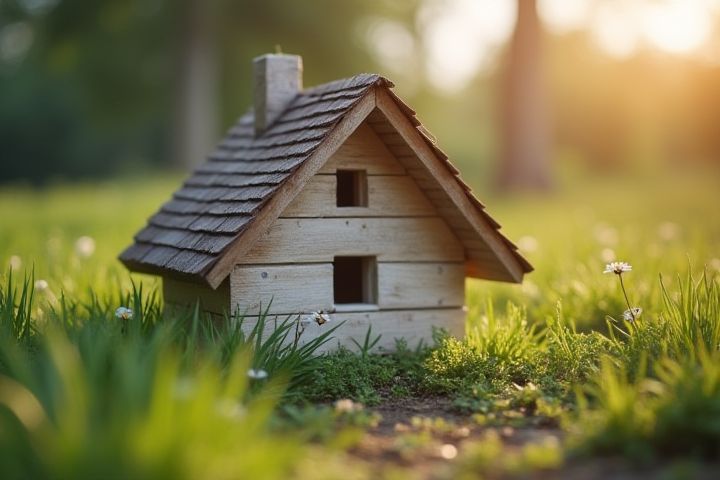
A house typically appreciates in value over time due to factors such as market demand, location, and improvements made to the property. According to real estate trends, properties in desirable neighborhoods often see higher appreciation rates driven by local amenities, schools, and economic growth. Additionally, the overall housing market conditions can influence appreciation, with factors like interest rates and the job market playing significant roles. Homeowners can also increase their property's value through renovations and maintaining curb appeal, which attracts buyers. Understanding these dynamics can help you make informed decisions about investing in a home.
Will A House Appreciate In Value
Location and neighborhood
The appreciation of your house's value is significantly influenced by its location and the surrounding neighborhood. Properties situated in desirable areas with access to schools, parks, and shopping tend to experience higher demand, thus driving up market value. Safe neighborhoods with low crime rates and strong community engagement also contribute positively to property appreciation, attracting more buyers. Investing in a home within an up-and-coming area can yield substantial returns as development projects and infrastructural improvements enhance the overall appeal.
Market trends and cycles
Real estate appreciation typically aligns with market trends and cycles, influenced by factors such as location, economic conditions, and demand. Historically, homes in desirable neighborhoods have seen annual appreciation rates ranging from 3% to 7%, dependent on local market dynamics. Economic indicators like employment rates and interest rates also play critical roles; for example, a 1% drop in mortgage rates can lead to a significant uptick in homebuyer activity. Understanding these trends can help you anticipate market movements and make informed decisions about property investment.
Property condition and updates
A well-maintained house typically appreciates in value due to its condition and the quality of updates made over time. Essential renovations, such as a modern kitchen or updated bathrooms, significantly enhance buyer appeal and can lead to higher market prices. Regular maintenance, including roof repairs and HVAC servicing, contributes to the overall health of the property, further increasing its longevity and value. Investing in energy-efficient upgrades not only attracts environmentally conscious buyers but also elevates your home's market position.
Economic factors and growth
A house typically appreciates in value driven by economic factors such as local job growth, wage increases, and overall demand for housing within the community. Areas with strong economic development attract businesses and new residents, leading to heightened competition for homes, which can push prices upward. Inflation also plays a role, as rising costs of materials and labor contribute to increased home values over time. By understanding these dynamics, you can make informed decisions about investing in real estate and anticipate potential appreciation in your property's value.
Interest rates and mortgage availability
Interest rates significantly influence the appreciation of house values, as lower rates generally encourage borrowing, boosting demand for homes. According to recent data, a 1% decrease in interest rates can lead to a 10% increase in home purchasing power, which can drive up market prices. Conversely, when mortgage availability tightens due to higher interest rates, potential buyers may be deterred, leading to slower appreciation or even depreciation in housing values. Monitoring mortgage availability and prevailing interest rates is crucial for understanding potential shifts in your property's market value.
Population growth and demand
Population growth significantly influences housing demand, leading to increased property values over time. In urban areas, a 1% growth in population can result in a 3% rise in housing demand, often outpacing supply. This situation creates competition among homebuyers, driving up prices. Investing in areas experiencing population surges can enhance the potential for your property's appreciation.
Infrastructure development
Infrastructure development significantly impacts house values, often leading to appreciation. For instance, homes located near new transportation hubs or major road expansions have shown an increase in market value by up to 20% within a few years. Improved access to amenities such as schools, parks, and shopping centers can also enhance desirability, further driving up prices. By investing in properties close to ongoing or planned infrastructure projects, you may enjoy a substantial return on investment as demand escalates.
Property supply constraints
The appreciation of a house's value often hinges significantly on property supply constraints in the real estate market. When housing supply is limited, driven by factors such as zoning laws, land scarcity, or construction delays, demand typically outpaces availability, creating upward pressure on property prices. Your investment could see substantial returns if you purchase in an area facing stringent supply limitations, as this environment fosters competition among buyers. Consequently, understanding local market conditions and future development plans is crucial to predicting potential value appreciation effectively.
Rental yield and investment potential
Residential properties typically appreciate in value over time, with an average annual appreciation rate of around 3% to 5% depending on the location and economic conditions. Rental yield, which measures the annual rental income as a percentage of the property value, can range from 6% to 10% in prime markets, making real estate an attractive investment option. Investing in houses in areas with strong job growth and low vacancy rates can enhance appreciation potential while ensuring a steady stream of rental income. For your investment strategy, consider properties with renovations and amenities that appeal to tenants, increasing both rental yield and future resale value.
Historical appreciation rates
Historically, residential properties in urban areas have demonstrated an average appreciation rate of 3-5% annually over the past few decades. Factors such as location, economic growth, and housing supply significantly influence these rates; for instance, homes in metropolitan regions can appreciate as much as 10-12% during boom periods. Real estate markets often fluctuate, but long-term trends indicate that homes typically increase in value, driven by demand and inflation. Investing in a home may not only provide a place to live but also an opportunity for substantial financial growth over time.
